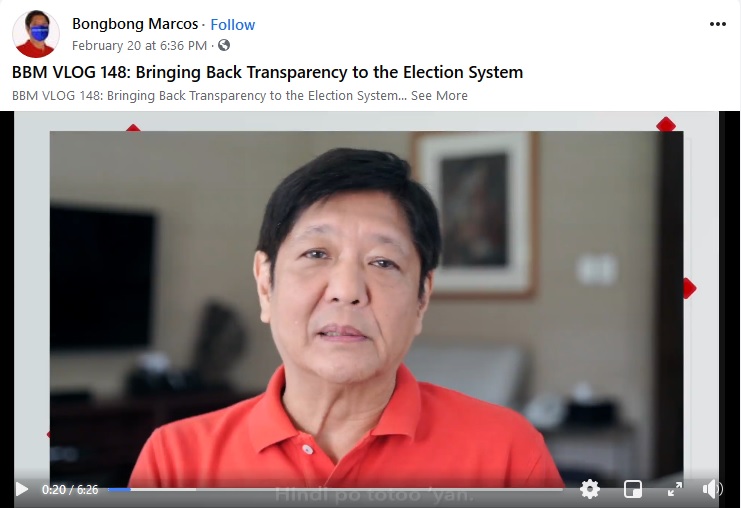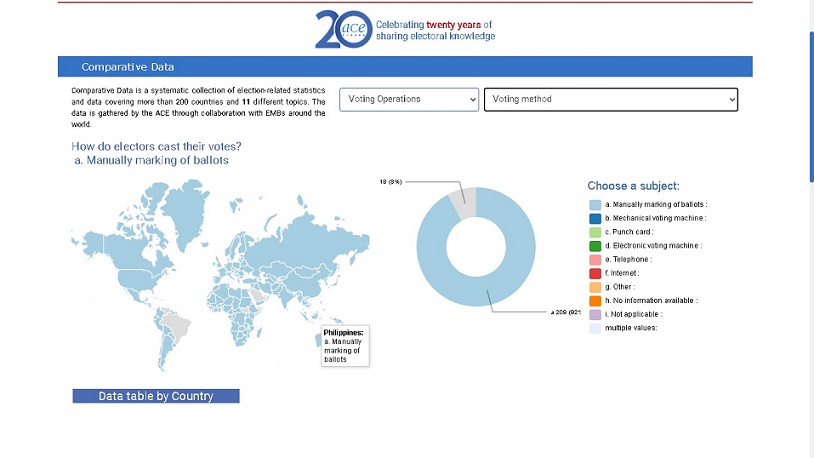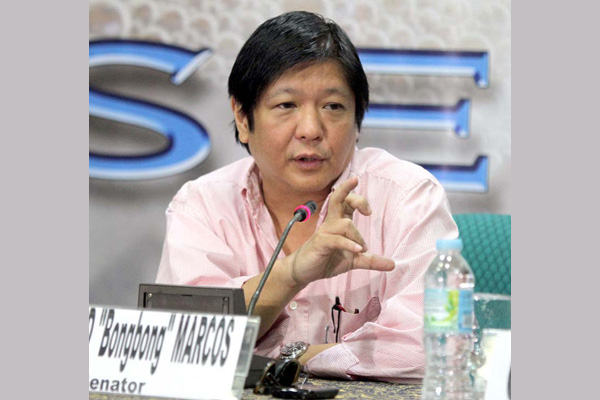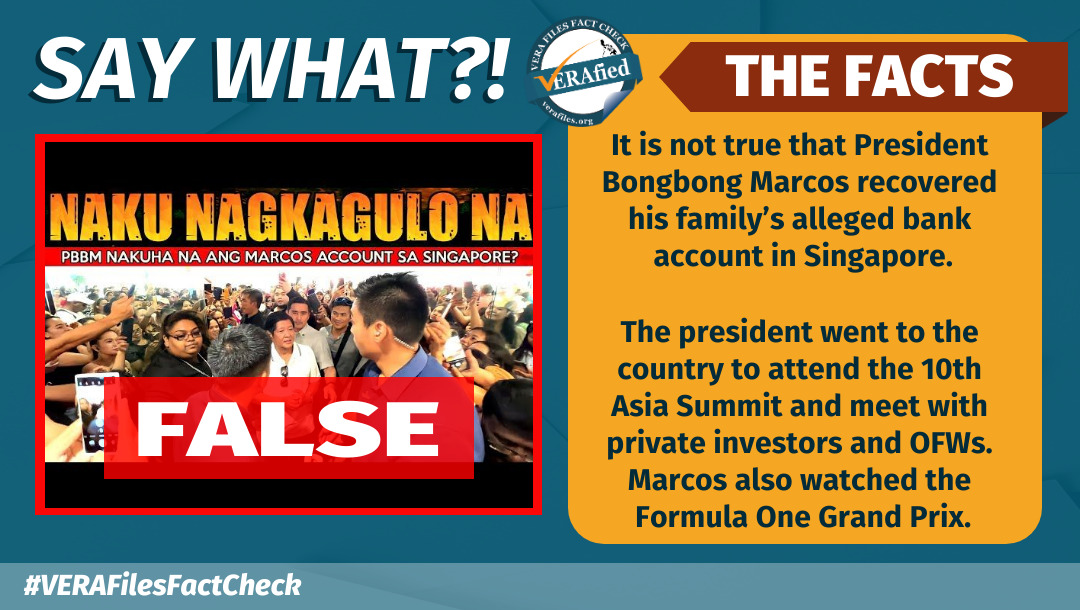There are at least seven false claims, misrepresentations or elements requiring context in Bongbong Marcos’s latest vlog, BBM Vlog 148, titled “Bringing Back Transparency to the Election System” posted after the Supreme Court (SC), sitting as the Presidential Electoral Tribunal (PET), dismissed Marcos’ protest of Vice President Leni Robredo’s victory last Feb. 16.
Contentwise, Marcos’s Vlog 148 it is a revised version of his Vlog 145, “Hybrid Election System for 2022,” which was uploaded on January 30, 2021. The “new” entry adds a title card, portions—largely from trailers, it seems—of the 2020 HBO documentary Kill Chain: The Cyber War on America’s Elections, and other additional visuals, such as a list of updates regarding the hybrid election bills filed in Congress. Marcos did not record new material for BBM Vlog 148.

These are the vlog’s false claims or misleading contents:
1. The vlog’s title card states that the Tribunal’s announcement on February 16 concerned only “the dismissal of the recount,” not Marcos’s third cause of action (the annulment of votes due to alleged fraud in three provinces in the Bangsamoro Autonomous Region in Muslim Mindanao, or BARMM). This claim—initially made by Marcos’s lawyer Vic Rodriguez, in a statement dated February 16, 2021 and released via social media—has been debunked numerous times over the last few days by the SC spokesperson Brian Hosaka (by stating in a press briefer that the “entire electoral protest” of Marcos had been junked), Chief Justice Diosdado Peralta, and independent fact-checkers.
2. Marcos says, “sa 227 na bansa sa mundo na nagkakaeleksyon, 209 ang gumagamit ng manual voting” (in 227 countries in the world where elections are held, 209 use manual voting). This is different from what appears in the animated text accompanying Marcos’s narration: “209 out of 227 countries still use paper ballots.”
Based on the likely sources of these numbers, the latter is the factual statement. The vlog does not disclose the source for these seemingly similar but significantly different statements, but they were most likely quoting an October 30, 2020 article uploaded on the Pew Research Center website titled “From Voter Registration to Mail-in Ballots, How Do Countries Around the World Run Their Elections?” There, one will find this sentence: “Votes are cast by manually marking ballots in 209 of the 227 countries and territories for which the ACE Electoral Knowledge Network has data.” A link is provided in the article to the website of the ACE Electoral Knowledge Network (https://aceproject.org/), where one can generate the following map showing the 209 countries that manually mark ballots:

Source: ACE Electoral Knowledge Network
Unlike what Marcos is insinuating, the Philippines is in fact clearly among the 209 countries that still mark ballots manually, as opposed to using online or e-voting or direct recording electronic voting machines. The Philippines does not use “completely/purely electronic voting,” a phrase that Marcos repeatedly uses in his vlog.
3. Marcos’s vlog suggests that “manual voting” excludes voting that uses paper ballots but counts votes electronically, i.e., the system currently used in the Philippines. Again, the ACE Electoral Knowledge Network (https://aceproject.org/epic-en/CDCountry?country=PH) describes the Philippines as a country wherein voters manually mark ballots and use electronic voting machines.
4. To further bolster his partial de-automation advocacy, in the vlog, Marcos claims that some countries are discarding automation, returning to manual processes. This is true. However, among the accompanying news articles that the vlog shows while Marcos is talking, only one, “Fearful of Hacking, Dutch will Count Ballots by Hand” published by the New York Times recalls the Philippine case. The rest are about online or direct electronic entry elections.
Marcos quotes from an article regarding elections in Finland, stating that it is about “completely electronic elections.” “Sabi nila yung risks ay masyadong malaki para sa benefits” (They say that the risks far outweigh the benefits), Marcos says. However, the article is about a very particular form of automated elections: online voting. Even the highlighted text from the article—titled “Security Fears Delay Roll-out of National E-voting in Finland,” which first appeared on Computer Weekly—that Marcos is supposedly quoting from only talks about online voting: “‘Our present position is that online voting should not be introduced in general elections as the risks are greater than the benefits,’ said [Johanna] Suurpää [chair of the e-voting working group of Finland’s Ministry of Justice].”
The Philippines has never utilized any form of direct electronic vote entry or online voting for national or local elections.
5. Marcos says, “Nung 2013 ay nasa 76% lamang ang boto na natransmit o nabilang” (in 2013, only 76% of the votes were transmitted or counted). Again, this does not tie up completely with the text being flashed on screen: “[in 2013,] only 76% of the votes were transmitted.” By adding the word “nabilang,” Marcos is stating that votes that were not transmitted were not counted at all, effectively disenfranchising (hundreds of) thousands of voters. However, according to former Smartmatic lawyer (later two-time Duterte appointee) Karen Jimeno and the Comelec, votes that are not transmitted are still counted because the SD cards where the votes are recorded will be physically delivered to canvassing centers. The Center for People Empowerment in Governance (CENPEG) confirms that these contingency measures have indeed been in place since the first automated elections in the Philippines in 2010, though it noted that there were cases wherein such physical transportation lacked security measures.
Marcos also highlighted the 961 defective vote-counting machines and 1,000 SD cards that needed replacement during the 2019 elections. He did not mention what was widely reported: the defective machines were also replaced.
6. After discussing the glitches in other automated elections in the Philippines, Marcos says, “At naman nung 2016 ay siguro alam na natin ang nangyari” (And then in 2016 we suppose we know what happened), implying that he was a victim of the flaws of and fraud in the election system. In BBM Vlog 145, he said this without any related visuals.
In Vlog 148, this statement is followed by a quick flash of a claim posted on Facebook showing two partial and unofficial results purportedly of a barangay in BARMM where Leni Robredo was the only vice presidential candidate to receive votes, followed by brief flashes of what seem to be photographs of the wet/damaged ballots and ballot boxes that were found when the ballots in the three provinces identified by Marcos were undergoing revision.
Regarding the Facebook post, besides the pictures showing only partial and unofficial results, it is not proven how getting zero votes in a barangay is an indication of fraud. A Rappler article dated May 17, 2016 pointed out that based on partial unofficial results, there were more zero-Robredo vote precincts than zero-Marcos vote precincts, and Marcos “got more votes from precincts that gave Robredo zero votes.” Considering the 2019 senatorial election results, which have not been formally contested, it is also not unimaginable that in several areas in Mindanao, members of the Marcos family are unpopular among voters. Among the three provinces that are contemplated in Marcos’s third cause of action, based on the partial and unofficial results of the 2019 elections, Imee Marcos entered the “magic 12” in only one: Basilan. In Maguindanao, Imee placed 13th, and in Lanao Del Sur, she placed 17th.
Regarding the wet ballots, on pages 42-43 of the October 15, 2019 resolution of the PET on Marcos’s protest, one will find the following: “In the course of the revision [of ballots], the Tribunal observed that the paper ballots in several clustered precincts were wet and unreadable, or their integrity was compromised such that it rendered revision using paper ballots impossible. For these clustered precincts, the Tribunal directed the use of the decrypted ballot images provided by the COMELEC for purposes of revision. The parties registered their claims and objections thereto.” The PET then found that there were no decrypted ballot images for three clustered precincts, and thus excluded them from the revision. However, when added up, the total votes in these precincts were only 910 votes.When the revision was completed—disregarding the wet ballots issue when decrypted ballot images were available—according to the PET, the lead of Robredo over Marcos increased from 263,473 to 278,566 votes.
7. Finally, in the first minute of the video, Marcos says, “Ang sinasabi, yung manual counting ay masyado raw matatagalan. Hindi po totoo ‘yan. Hindi po ito mas matagal kaysa purely electronic na voting” (They say that manual counting takes too long. That’s not true. It’s not true that it takes longer than that in purely electronic voting). Later on, Marcos claims that the manual counting of the votes in a (clustered) precinct, or about 600-800 votes, may be done within 1-2 hours.
This is impossible; in a ballot during a presidential election year, one will have to vote for a president, a vice president, twelve senators, a district congressional representative, a partylist, and local government positions (e.g., governor and vice governor and/or mayor and vice mayor and provincial board members and/or municipal/city council members). During midterm elections, the only positions absent from the ballots are president and vice president. Reading and manually recording the votes in one ballot and verifying if the ballot was appreciated correctly, to the satisfaction of all precinct poll watchers, will obviously take much longer than a few seconds (800 ballots counted in two hours means around 6-7 ballots counted per minute).
Moreover, according to a 2004 document titled “CEPPS Philippines Election Observation Program – Strengthening the Electoral Process” by Peter Erben, Beverly Hagerdon Thakur, Craig Jenness, and Ian Smith of the International Foundation for Electoral Systems, available at the ACE Project website, before automation, “an average of 20 votes were counted per hour with each precinct counting approximately 200 ballots.”
Marcos—or his vlog’s scriptwriters—may have misunderstood what hybrid election system advocate Gus Lagman said regarding his projected timeframes. Lagman, in an article dated March 13, 2013, titled “Does Smartmatic’s PCOS Add Value or Problems to our Elections?” posted at The Movement for Good Governance website, “manual precinct counting only takes 5-12 hours.” According to Lagman, it’s the “printing, the visual checking, the re-encoding, and the iteration” of the steps of transmitting PC/laptop encoded election returns—done after counting—that “might take 1-2 hours.” When Lagman’s proposed Patas system was tested in Bacoor, Cavite on June 27, 2015, multiple news outlets reported that only 20 ballots, covering only the votes for national positions, were counted in 41 minutes.
The system proposed by the Marcos siblings bear similarities to Lagman’s PATAS system. According to then Election Commissioner Christian Robert Lim, as discussed in a Philippine Daily Inquirer article dated July 10, 2015, “Patas’ manual procedure is time-consuming, taxing and prone to human error.”
Perhaps, given all of the above, the eighth misrepresentation in the vlog is Marcos appearing to know what he is talking about.
The vlog strongly suggests that Marcos lost only because of fraud and a flawed system. He notes that the youth are apparently losing interest in elections, claiming that he believes this to be largely due to the defective election system. For visual support, the vlog flashes an article titled “Philippine Youth Losing Faith in Political System.”
The article, posted in the Deutsche Welle website, in fact highlights youth being disheartened by the loss of opposition senatorial candidates in 2019 to candidates such as “a former dictator’s daughter,” i.e., Imee Marcos. Another accompanying visual is a screenshot of the results of a survey which asked one multiple choice question: “Bakit hindi ka pa nagpaparehistro?” The majority in this survey indeed answered “Walang Tiwala Sa Sistema” (No trust in the system). But despite bearing what looks like an infographic with the Comelec logo, it does not appear to have any connection to the election agency. The full survey results, which can be viewed here, indicates that the survey was conducted online between February 6 and February 12, and had only 626 respondents, and restricted responses to three: besides “Walang Tiwala sa Sistema,” one could answer with “Covid, Takot Pa Lumabas” (Covid, scared of going outside) or “Hindi Ko Alam Paano” (I don’t know how [to register]). But the mismatched visual and the clearly unscientific survey may be excused in this instance, since Marcos couched his claims about the youth losing enthusiasm in elections as opinion rather than fact—something Marcos should have done for several other claims in his vlog.
(Miguel Paolo P. Reyes is a researcher at the Third World Studies Center, College of Social Sciences and Philosophy, University of the Philippines Diliman.)
(The views in this column are those of the author and do not necessarily reflect the views of VERA Files.)




